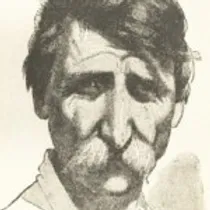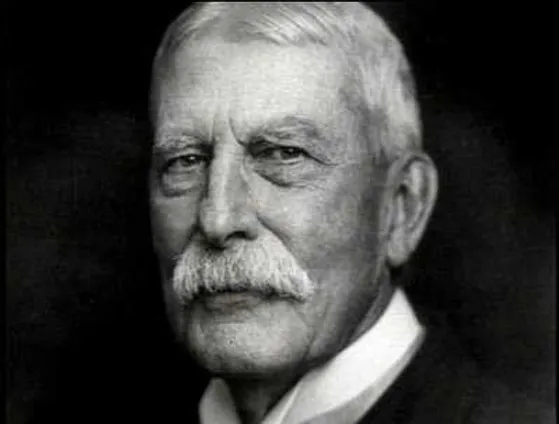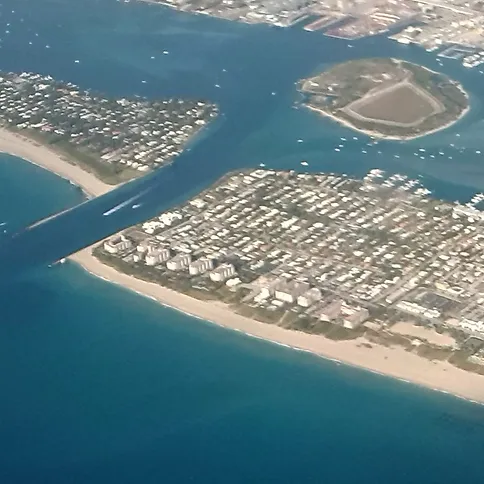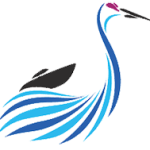Lake Worth Lagoon History
In a time of modern electronics, state of the art equipment and seeing our surroundings virtually the same throughout our lives, its hard to imagine how things became what they are today. Admittedly, history has never been an interest of mine but the more I learn about the area I navigate daily, the more interesting history becomes, mostly because, it’s a topic of interest. So lets explore the history of the Lake Worth Lagoon.

Sandhill Charters operates out of the once freshwater and formally named Lake Worth Lake. The body of water now known as the Lake Worth Lagoon, has had quite the transformation since the time of the Civil War and is now home to one of the best snorkeling locations in Florida. It’s hard to picture the waterways without the Inlet or even the island for that matter. It’s hard to imagine the waters around the island as anything but saltwater, and easily take for granted how it all became what it is today.

Palm Beach Intracoastal Waterway
In an earlier post, I discussed how Peanut Island was formed, with the dredging of the Inlet and creation of the Port of Palm Beach. This area of waterway makes up a large portion of the now saltwater Intracoastal Water Way in Palm Beach County, ICW for short, and is heavily used by commercial ships, yachts, pleasure boaters and a host of marine life. As a side note, if you are in the area in winter months, the Manatee Lagoon next to the Port of Palm Beach is a trip you will want to take as Manatees flock to the area due to the warm water discharge of the Power Plant. But if the lagoon was once a freshwater lake, that would mean only one thing; the inlet did not used to exist at all.

Mar-A-Lago "Sea to Lake"
Most people know about the home of former President, Donald Trump, as Mar-A-Lago, which is both a resort and national historic landmark here in Palm Beach county. Mar-A-Lago, translated from Spanish means Sea to Lake. The name came about because the east side of the property lies on the Atlantic and the west side lies on the ICW with the latter previously being a lake. Today, the Lake Worth Lagoon is no longer a closed off lake as there is not one, but two man made open accesses to the Atlantic Ocean.
Palm Beach County Inlets
Palm Beach County currently has 4 inlets that have direct access to the Atlantic Ocean. But prior to 1860, only the naturally made Jupiter Inlet at the north side of the county, and the Bocca Inlet at the southern most part of the county, existed. Both the South Lake Worth Inlet (known as the Boynton Inlet) and the Palm Beach Inlet (known as the Lake Worth Inlet) were man made and neither stayed located in their original spots for long.
Previously sealed off from the Atlantic, the Lake Worth Lake was a freshwater body of water fed by the run-off from lakes and other bodies of water from the west. Only occasionally would heavy storms cause breaches in the lake, allowing sea water to enter over the narrow land mass, typically on the northern side. Amazingly enough, though the land mass or barrier islands (for lack of a better word) are not all that wide, the Lake Worth Lake remained largely salt-free and wouldn’t even have been considered “brackish” water by even the most loose definitions. But all that would change around the time of the Civil War when one man single handedly changed the landscape forever, and by mere coincidence, changed how the water way would be used forever to come.
Augustus Oswald Lang

In the mid 1860’s a German man named Augustus Oswald Lang, considered by some as being the first white settler in Palm Beach County, had taken up residence in the area after moving south from Fort Pierce.
Jupiter Lighthouse

Prior to moving, Lang was an assistant lighthouse keeper at the Jupiter Inlet Lighthouse when the Civil War broke out and he sided with the South.
In 1861, 30-year-old Lang, along with other Confederate-backed loyalists, ordered his boss, J.F. Papy, to surrender the lighting mechanism in an attempt to hinder the Union ships. Papy, who received a federal paycheck and was dedicated to his mission to keep boaters safe refused but eventually caved to the pressure to relinquish the light.
During the wars, lighthouses were often times disassembled and the parts destroyed rendering them useless. Luckily for the Jupiter Lighthouse, Lang understood the immense value of the light mechanism and simply hid the disassembled parts.
Jupiter Lighthouse Fresnel Light
The Fresnel light of the lighthouse, was the best of its kind at the time and would have cost $5000 back then to replace. Factoring inflation, that would amount to a whopping $168,278 if purchased today.
Fortunately, all the removed parts were found and transported to Key West for safe keeping and later returned to the lighthouse. The Jupiter lighthouse was out of commission for 5 years (1861-1866)

Lang settled along the shores of Lake Worth and remained undiscovered largely due to how hard the area was to reach by boat, which needed to navigate the twisting and turning rivers and could only be steered by pole barge. In the summer, the mosquitoes were abundant with the amount of standing water and was the perfect breeding ground for malaria and other diseases the mosquitoes carried. I can certainly vouch for how bad the Florida mosquitos can be and locally nicknamed “Skeeter Hawks”. Once settled, Lang took up his old hobby of gardening and it is believed he used to be the gardener for the King of Prussia before immigrating from Germany. It is this time in Lake Worth when he cultivated many exotic trees and plants that future settlers in the area would eventually use.

Lang's Inlet
I can only speculate here, but I’m assuming Lang must have grown tired dragging his boat back and forth over land to fish both the Atlantic waters and the Lake, and devised a plan to remedy the situation not knowing the future impact that decision would have. At some point during the early to mid 1860’s, Lang hand dug a narrow trench through the beach ridge which allowed the fresh water lake to rush out. This water rushing out of the trench cut, widened into a small inlet as the lake lowered to sea level, effectively transitioning the freshwater lake into the saltwater Lake Worth Lagoon. This small inlet would be appropriately be known as Lang’s Inlet.
Lang’s Inlet faced issues we still deal with today. Silting closed off the inlet several times requiring to be dug out and opened up again only to succumb to silting once more. The fundamental issue at hand that would take some time in the future to solve, was the effects of littoral drift. The ocean is constantly moving through waves and wind and as a result, sand and shell fragments are caught in the motion. The Gulf Steam flows northward along the Florida east coast, however littoral drift moves sediment from the north and pushes south as waves interact with land. This effect essentially causes shoaling or sandbars to form around inlet openings effectively closing them off which then requires it to be frequently dug out to keep clear.
In 1866, two settlers from what is now Miami, found Lang living in what is known today as Palm Beach, and to Lang’s surprise, the war had already ended. In around 1867 Lang moved to the North Fork of the St. Lucie River where he continued to work with his love of plants along with raising hogs and cows.
In 1877 after Lang’s Inlet had closed off multiple times, the local settlers were working out a plan to either improve the inlet, or relocate it all together. The existing inlet had long become a nuisance as it was constantly closing off when it was needed to be used the most and the settlers grew tired of having to dig it back out every few months. The decision was made to create a new inlet further north from Lang’s closed off inlet. The settlers found the best spot about a mile north, close to a rock point called the Black Rocks. The beach ridge in that area was quite narrow for about 300 yards and the rocks would create a natural jetty. It took the combined efforts of 20 men over several weeks to clear the land which was full of vegetation, and to do the removal of tons of sand with shovels and wheel barrows.
The inlet location was one of the best along the coast, but it too fell prey to the ever constant silting. The settlers knew that as long as the inlet was near the rocks, it offered the best chances of staying open. However, over the years the inlet still shifted about a mile south once again. Knowing the rocks stood no chance of helping keep the inlet from closing off at that distance, they went back to the drawing board to come up with a better plan; an inlet on a grander scale than anyone at that time had dreamed. After executing their plan, the new inlet was more than a hundred yards wide but was far from stable.
Henry Flagler

It wasn’t until 1893 when Henry Flagler, who had a prominent impact of the local area, had the inlet enlarged. Still with issues, in 1905, Flagler said he would commit funds toward reopening the inlet. The Federal Government would give unfavorable responses to local residence who requested help in improving and maintaining this inlet, which was growing tremendously more important for local trade. It wasn’t until 1915 when the Florida State Legislature chartered the Lake Worth Inlet District, later called the Port of Palm Beach District. The Lake Worth Inlet District received overwhelming public support a year later to fund the inlet projects. Well known engineer Isham Randolph was selected for the project and after a survey of the land found that the site of the old Lang Inlet was the best spot, and is the current location of the Lake Worth Inlet.

The story isn’t over for the Lake Worth Inlet. Even with advancements in technology and equipment, additional funding and the federal governments involvement, the Lake Worth Inlet is still met with the challenges every inlet faces. In fact, this marvel of engineering created a new problem that needed to be solved; the interruption of littoral drift which in turn caused the retreat of the shoreline causing 8.5 miles of erosion south of its location. I will post a follow-up article to this one on just how that problem was solved and is still in use today.


